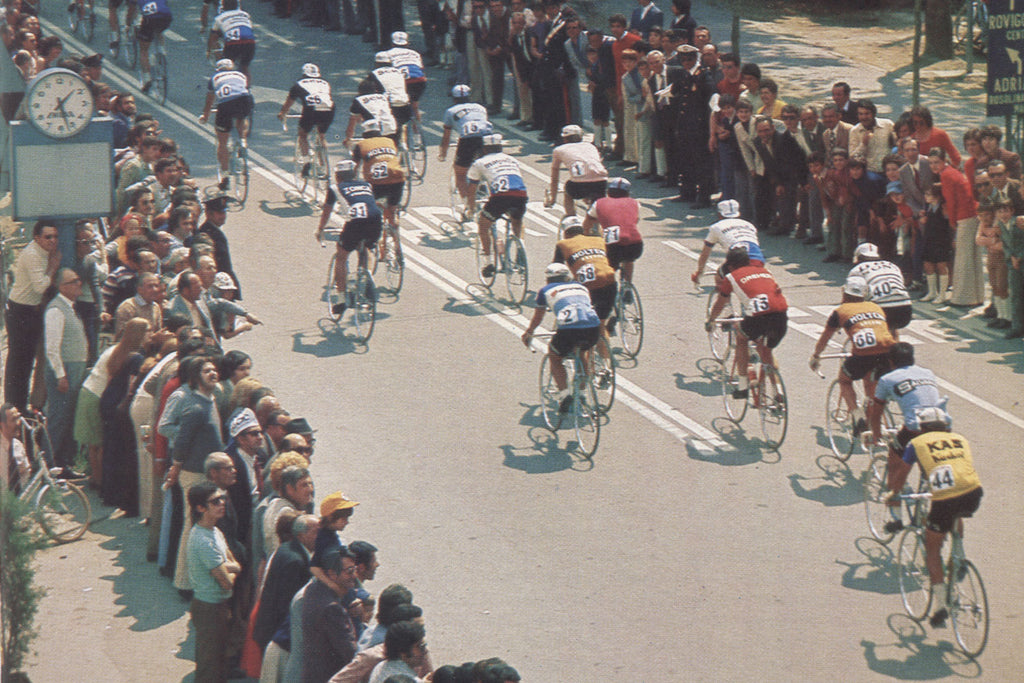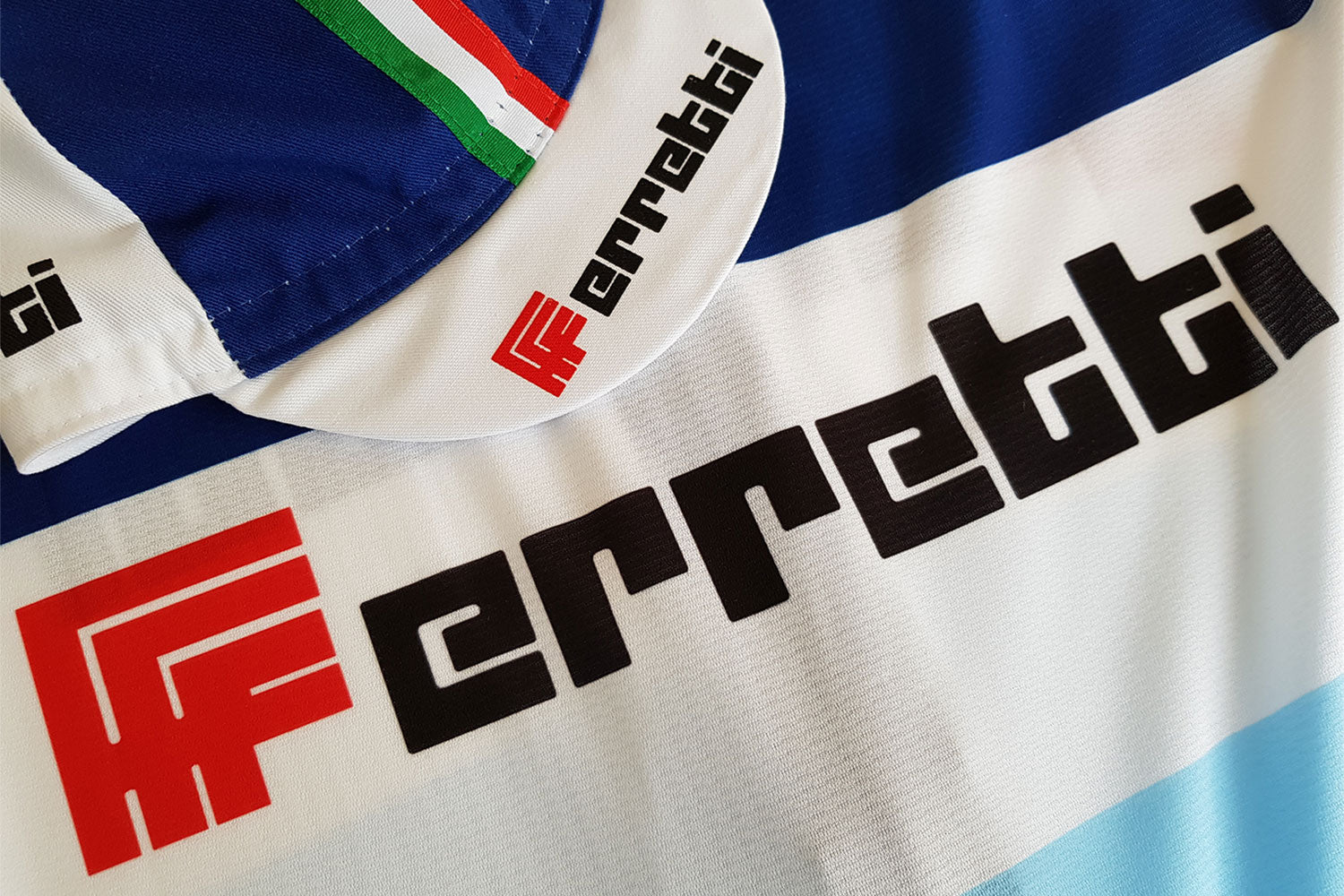QUALITY CYCLING CLOTHING SINCE 1996 - THE UK'S FIRST RETRO MANUFACTURER
QUALITY CYCLING CLOTHING SINCE 1996 - THE UK'S FIRST RETRO MANUFACTURER
RETRO APPAREL
COLLECTIONS
Cycling Clothing
ACCESSORIES
Ferretti Cycling Team - Fratelli D'Italia
May 02, 2019 6 min read

Join respected author & journalist Herbie Sykes who looks back to when the Ferretti cycling team joined the professional peloton and brought along the Swedish Pettersson brothers along for a truly meteoric journey.
Full swing…
Vespa and Lambretta, IGNIS and Philco, Lancia and Alfa Romeo. Hand-cream and toothpaste, bottled water from the Alps and aperativi from Turin. Pre-packed meats from Arcore, dried pasta from Cesena, Brazilian coffee from Milanese satellite towns.
The miracolo economico had started in 1949, and the Italians had been congratulating themselves on it ever since. Everyone had been swept along, and everyone had played along. The political classes crowed that 8 per cent year-on-year had been entirely of their making, the natural consequence of some unspecified economic alchemy. Cloying, glad-handing bosses boasted of their perspicacity, mealy-mouthed factory workers of their “unity of purpose” and Stakhanovite endeavour.
On the beach, in the works canteen and at their luminous new supermercati, their women boasted of fridges, FIATs and flats. Television sets and washing machines had bedecked and embellished, and now white collars, mortgages and university educations legitimized. They'd rolled up their sleeves figuratively and literally, they told themselves, and their fortitude had been rewarded. Viva l’Italia…
A nice conceit, but a conceit all the same. Italy had been one of the countries most at risk of the communist contagion, and the Americans had needed to mitigate the risk. They were cash rich, so they’d pumped billions in. For “unprecedented economic boom” read “European Recovery Programme”. Read “Marshall Plan”, “geopolitical imperative and “client state in perpetuity”. Good old Uncle Sam.
And so, breathlessly, to fitted kitchens. The Salvarani brothers were from Parma, and they’d built the Salvarani cycling team around Ercole Baldini. That had been a mistake, because Baldini had been the man of ’58. Poor Ercole was prehistoric, so they’d replaced him with Vittorio Adorni and fresh-faced Felice Gimondi. In two ravenous months they’d won them the pink jersey and the yellow, and a lifetime of brand awareness thanks to the Salvarani jersey. Unparalleled prestige, and an order book to die for. Italian women loved their kitchens, and their menfolk loved their cycling team.
Would you like a team at the Giro d'Italia?
There were six of those Salvarani brothers, but only four Ferrettis. They built their kitchens in Capannoli, southeast of Pisa, and they loved cycling too. Their business was booming, and in January 1969 the brightest of them, Piero, took a call from a triple-winner of the Giro d’Italia. They danced around it a little bit, but then Fiorenzo Magni landed the sucker punch. He popped the old “Would you like to have your very own team at the Giro d’Italia?” question and Piero Ferretti went all weak at the knees just as he’d known he would.
When he came off the ‘phone he told Renzo, Gianpaolo and Erasmo that he’d spent the entire marketing budget, that the four F’s of their logo would look great on a cycling jersey, and that if Salvarani could do it, why not them?
Meantime Magni rang his old mate Alfredo Martini, down the road in Florence. They’d won the Giro together in ’48 and ’55, and Martini had been a character witness when he’d stood trial for the massacre of those partisans at the end of the war. Fiorenzo owed ‘Fredo his freedom, his fame and fortune, so the least he could do was help him out with a job as a DS. He told him the Ferretti boys were in, so he’d best get himself over to Capannoli pronto. He’d be needing bikes, kit, a team car and a dozen riders, and the Tour of Sardinia would be starting on 23 February.
Martini looked over the incassati, the riders who didn’t have a contract. He took a punt on Albert Van Vlierberghe (Flemish, brilliant, by all accounts washed up), and added a couple of Italy’s best trackies. One of them, Giuseppe Beghetto, had just a rainbow jersey in the sprint, and he galloped home twice in Sardinia. That wasn’t bad for starters, but then Van Vlierberghe topped it with a stage win at the Giro. Piece of cake this cycling lark...
Signing the Pettersson brothers
In November, the Ferretti four met Tomas, Gösta, Sture and Erik; the brothers Pettersson from Fåglum in Central Sweden. They’d helped themselves to their third amateur TTT World Championship and had been persuaded that professional cycling wasn’t lousy with doping after all.
They signed up, brought their wives and kids along, and the Ferretti family installed them a huge kitchen at a villa on the Tuscan coast. The rest is the history of Sweden’s most famous sporting family, and one of Italian cycling’s more iconic jersey designs - the Ferretti team jersey.

Gösta Pettersson won Romandy, and then podiumed at his debut Tour. In the autumn he and Tomas, the youngest and perhaps most gifted of the brothers, smashed it out of the park at the Trofeo Baracchi. They thumped the Danes Ritter and Mortensen (good), the Belgians Van Springel and In t’ Ven (better), and humiliated Gimondi and Motta (best).
The Ferretti brothers pushed the boat out once more that Winter, and signed three-time Giro runner-up Italo Zilioli. With Eddy Merckx absent, he and Gösta would go toe-to-toe with Motta and Gimondi at the Giro; Ferretti versus Salvarani for the biggest prize in Italian sport. Seconds out…
Salvarani won the phoney war, an insane (and yet strangely beautiful) opening day relay time trial down in Puglia. Two days later, though, the Giro did for them in precisely the way it had been doing for favourites for sixty years.
Motta and Gimondi had been the best of enemies for a decade. They neither liked nor trusted one another, and the notion that they might work harmoniously together was fanciful in the extreme. Gimondi had been under the weather prior to the race, and he'd been a passenger during the relay. Rival teams hadn't necessarily noticed it, but Motta knew full well that it represented a major opportunity. An ailing Gimondi was a sitting duck, and when the chance to attack him presented itself on stage three, Motta accepted gleefully. Moreover, he dragged along Gösta and, in Franco Bitossi, Michele Dancelli and Enrico Paolini, three more of the Giro’s superstars. They bludgeoned 2’44” into Zilioli, and fully 8’40” into Salvarani’s “co-leader”. Job done for Motta? Not quite. He tested positive for amphetamine, they penalized him ten minutes, and Salvarani were officially stuffed.
I started the seventh stage with seven minutes on Petterson, and a good chance of winning the Giro. However, you can't win the Giro on your own, and certainly not when you're riding against five teams.
I say five teams because I was riding against Salvarani, SCIC, Ferretti and Molteni, plus I'm pretty sure I was riding against my own teammates as well!
Ugo Colombo. Bitossi Cycling Team
Suddenly the Giro was Gösta’s to win or, if you will, to lose. He led Van Springel by 2’01” heading into the final Dolomite stage, with a 20-kilometre time trial to follow. When they crested the final climb, the Tonale, together, he seemed home and hosed. Gösta had one elemental problem as a cyclist, however, and it was his descending. Everyone knew it, and it was implicit that Van Springel would roll the dice one final time. To make matters worse some maniac – they never discovered who – had seen fit to throw nails onto the carriageway. Piero Ferretti and Alfredo Martini watched on horrified as Gösta first punctured, then remounted and finally slalomed down the Tonale to save his maglia rosa.
Ferretti pulled the plug at the conclusion of the 1972 season. By then they’d won more than 80 bike races; a truly meteoric rise. However Piero, in particular, had lived cycling 360°, and he was exhausted. Erik and Sture had had enough of Italy, and more than enough of the professional bike racing circuit. Tomas and Gösta signed on for SCIC, another kitchen manufacturer, but just like the boom economico, they were beginning to run out of steam.
To everything a season…
Buy the Ferretti retro long sleeve jersey, Ferretti retro cycling team jersey, and matching Ferretti retro cycling cap at Prendas Ciclismo.
Also in News and articles from Prendas Ciclismo

Prendas' Best-Selling Caps of 2024
January 21, 2025 4 min read
With 2024 in the books, we're looking back at your favourite caps of the year. From cult classic movies to the jungle with a whole lot of Italian flair, check out our best-sellers and grab a new cap!

Vas-y Barry! Hoban wins Ghent-Wevelgem for Gan Mercier Hutchinson
May 15, 2024 8 min read
In an extract from his autobiography, Vas-y Barry, the only British winner of Ghent-Wevelgem, Barry Hoban tells how he won the cobbled classic in 1974, beating Eddy Merckx and the cream of Belgian cycling.

Our Best Selling Caps of 2023
January 15, 2024 4 min read
We know caps here at Prendas Ciclismo, and we know that you love all the styles we have on offer. So every year, we look back at our best-selling cycling caps for the previous year for you to discover a few new styles. Is your favourite cycling cap featured on our list? Read on and see!
Subscribe
Sign up to get the latest on sales, new releases and more …


